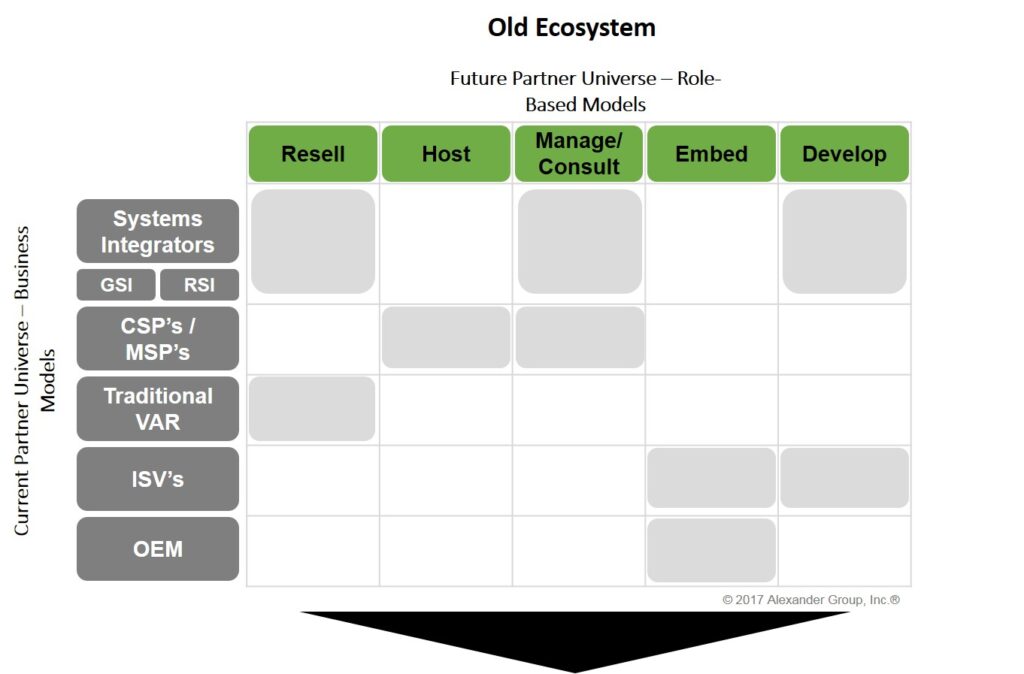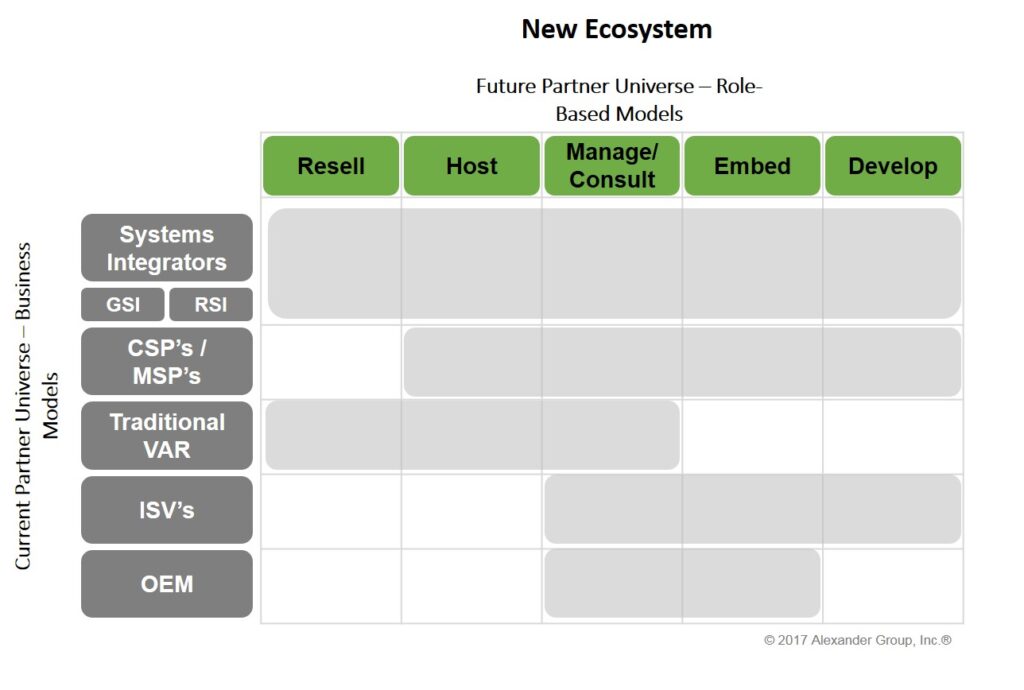Partner Management in a Shifting Technology Ecosystem

In the dynamic world of Cloud, XaaS, Big Data and IoT, partner ecosystems are evolving rapidly. Traditional partner segmentation models are breaking down as partners redefine their own operating models. While precise solutions are still emerging, all partner organizations should immediately consider three basic steps: reassess partner coverage, refocus value propositions and realign partner programs.
A Changing Ecosystem
Most technology companies base partner segmentation on their business model: Systems Integrator (SI), Cloud and Managed Service Provider (CSP/MSP), Value Added Reseller (VAR), and Independent Software Vendor (ISV’s). Partners must now reevaluate their own business models as much as vendors have over the past five years. Yet partner programs have remained stagnant.
As next-generation offerings begin to proliferate the industry, product offering complexity will increase, as will the need for broader integration. This will continue to drive growth in consulting and service-based offerings, as well as embedded technologies, across the partner ecosystem. With partner functions converging, what’s needed is a new way to segment and manage the ecosystem. One emerging model is the role-based partner model.
Role-Based Partner Model
Summary: The role-based model focuses on what functional or technological role a partner plays–as opposed to focusing on the title of the business. There are five partner roles in the hierarchy:
- Resell – Resell a product or offering on behalf of a vendor (traditional model)
- Host – Act as a cloud host for one or more service offerings (IaaS, PaaS, SaaS)
- Manage/Consult – Provide managed service or consulting service relative to implementation, maintenance, etc. of partner or vendor product
- Embed – Embed vendor product/service into partner product (applies to technologies and routes to market)
- Develop – Develop additional technology/offering/product using a vendor’s platform

 Whether or not the role-based model works at a given company, the changing dynamics of technology partner ecosystems necessitate revisiting partner coverage models and enablement programs. To begin the process of aligning your partner organization around new ecosystem roles, the Alexander Group recommends three initial steps:
Whether or not the role-based model works at a given company, the changing dynamics of technology partner ecosystems necessitate revisiting partner coverage models and enablement programs. To begin the process of aligning your partner organization around new ecosystem roles, the Alexander Group recommends three initial steps:
- Reassess Partner Coverage: The partners you need today may not be the partners you need tomorrow. Before organizations can realign enablement programs or value propositions, vendors should re-assess which partner roles are of increasing and decreasing importance. This reassessment, when compared to current state, will highlight where consolidation and recruitment efforts should focus. Analysis should center on gaps in coverage against vertical and horizontal priorities, geographies, and segments (e.g., SMB), as well as solution gaps in the technology itself. Once needs are clear, discussions should begin around the messaging and enablement required to execute the new partner strategy.
- Refocus Value Propositions: The new partner ecosystem requires different value messaging than the old. Rather than focus on traditional program elements like rebate amounts, MDFs, and high-touch training programs, marketing should focus on new ecosystem priorities. For go-to-market partners, this includes services and solutions they can quickly and easily scale, as well as services and solutions for which they can develop their own services. In the case of ISVs and technology alliances, partners are looking for clear land, expand, or adoption value propositions they can quickly leverage with minimal enablement time. The abundance of alliances in today’s ecosystem means less is more when it comes to gaining traction within partner sales teams. Outline the key components of the value message to each unique partner role in your ecosystem; and make sure the majority aligned to forward-looking objectives as opposed to traditional ones.
- Realign Partner Programs: After reevaluating your partners and value propositions, redesign partner programs to drive the desired level of partner engagement. AGI observes that next-generation partner programs are more accommodating to tiering models, while contract programs are more inclusive of the entire ecosystem. Vendors are creating master agreements that underpin multiple partner tracks–partners can mix and match tracks they participate in regardless of which business model they are segmented under. This approach helps eliminate unnecessary certifications that may not align with a narrowly focused partner’s objectives and improve ease of doing business overall. Vendors are also beginning to offer multiple pricing configurations to accommodate different partner operating models: subscription, usage/consumption-based, perpetual or licensed.
Closing Thoughts
As partner business models evolve in parallel with the technology industry, vendors should consider a more role-based view of the partner universe. Without this view, vendors risk treating partners in ways that are outdated relative to their own perceptions and objectives. While the solution may be unique in each case, there are clear and immediate steps to increasing your chances of partner success in the future.
Are you ready to reassess your partner segmentation model?
Contact an Alexander Group practice leader.
Learn more about Alexander Group’s Technology and Channel practices.
Read more Alexander Group insights on partner strategy and technology.